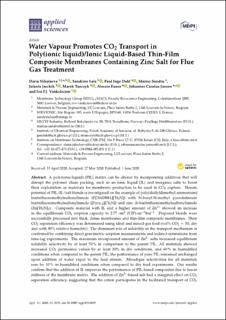| dc.contributor.author | Nikolaeva, Daria | |
| dc.contributor.author | Loïs, Sandrine | |
| dc.contributor.author | Dahl, Paul Inge | |
| dc.contributor.author | Sandru, Marius | |
| dc.contributor.author | Jaschik, Jolanta | |
| dc.contributor.author | Tanczyk, Marek | |
| dc.contributor.author | Fuoco, Alessio | |
| dc.contributor.author | Jansen, Johannes Carolus | |
| dc.contributor.author | Vankelecom, Ivo F. J. | |
| dc.date.accessioned | 2021-08-18T09:08:23Z | |
| dc.date.available | 2021-08-18T09:08:23Z | |
| dc.date.created | 2021-02-25T12:30:55Z | |
| dc.date.issued | 2020 | |
| dc.identifier.citation | Applied Sciences. 2020, 10 (11), . | en_US |
| dc.identifier.issn | 2076-3417 | |
| dc.identifier.uri | https://hdl.handle.net/11250/2770034 | |
| dc.description.abstract | A poly(ionic-liquid) (PIL) matrix can be altered by incorporating additives that will disrupt the polymer chain packing, such as an ionic liquid (IL) and inorganic salts to boost their exploitation as materials for membrane production to be used in CO2 capture. Herein, potential of PIL/IL/salt blends is investigated on the example of poly(diallyldimethyl ammonium) bis(trifluoromethylsulfonyl)imide (P[DADMA][Tf2N]) with N-butyl-N-methyl pyrrolidinium bis(trifluoromethylsulfonyl)imide ([Pyrr14][Tf2N]) and zinc di-bis(trifluoromethylsulfonyl)imide (Zn[Tf2N]2). Composite material with IL and a higher amount of Zn2+ showed an increase in the equilibrium CO2 sorption capacity to 2.77 cm3 (STP)cm −3 bar−1. Prepared blends were successfully processed into thick, dense membranes and thin-film composite membranes. Their CO2 separation efficiency was determined using ideal and mixed-gas feed (vol% CO2 =50 , dry and with 90% relative humidity). The dominant role of solubility in the transport mechanism is confirmed by combining direct gravimetric sorption measurements and indirect estimations from time-lag experiments. The maximum incorporated amount of Zn2+ salts increased equilibrium solubility selectivity by at least 50% in comparison to the parent PIL. All materials showed increased CO2 permeance values by at least 30% in dry conditions, and 60% in humidified conditions when compared to the parent PIL; the performance of pure PIL remained unchanged upon addition of water vapor to the feed stream. Mixed-gas selectivities for all materials rose by 10% in humidified conditions when compared to dry feed experiments. Our results confirm that the addition of IL improves the performance of PIL-based composites due to lower stiffness of the membrane matrix. The addition of Zn2+-based salt had a marginal effect on CO2 separation efficiency, suggesting that the cation participates in the facilitated transport of CO2. | en_US |
| dc.language.iso | eng | en_US |
| dc.publisher | MDPI | en_US |
| dc.rights | Navngivelse 4.0 Internasjonal | * |
| dc.rights.uri | http://creativecommons.org/licenses/by/4.0/deed.no | * |
| dc.subject | polymeric membranes | en_US |
| dc.subject | zinc | en_US |
| dc.subject | relative humidity; | en_US |
| dc.subject | thin-film composites; | en_US |
| dc.subject | CO2 transport; | en_US |
| dc.subject | poly(ionic liquid); | en_US |
| dc.subject | flue gas; | en_US |
| dc.title | Water Vapour Promotes CO2 Transport in Poly(ionic liquid)/Ionic Liquid-Based Thin-Film Composite Membranes Containing Zinc Salt for Flue Gas Treatment | en_US |
| dc.type | Peer reviewed | en_US |
| dc.type | Journal article | en_US |
| dc.description.version | publishedVersion | en_US |
| dc.rights.holder | This is an open access article distributed under the Creative Commons Attribution License which permits unrestricted use, distribution, and reproduction in any medium, provided the original work is properly cited | en_US |
| dc.source.pagenumber | 19 | en_US |
| dc.source.volume | 10 | en_US |
| dc.source.journal | Applied Sciences | en_US |
| dc.source.issue | 11 | en_US |
| dc.identifier.doi | 10.3390/app10113859 | |
| dc.identifier.cristin | 1893668 | |
| dc.source.articlenumber | 3859 | en_US |
| cristin.ispublished | true | |
| cristin.fulltext | original | |
| cristin.qualitycode | 1 | |

